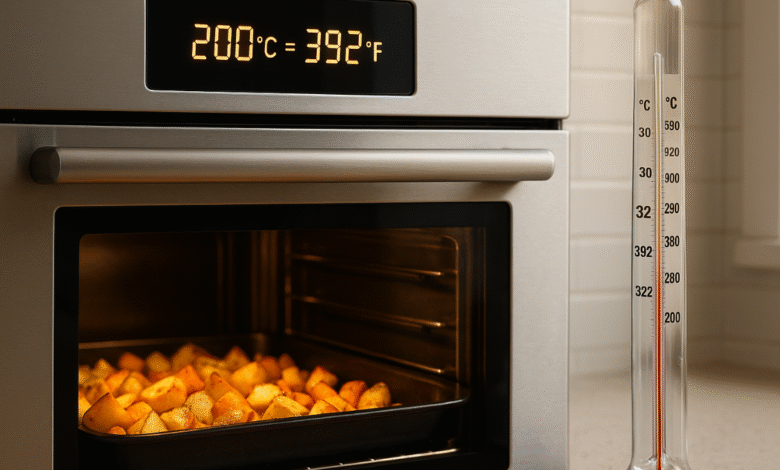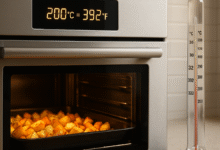What is 200 Degrees Celsius in Fahrenheit? Easy Conversion Explained

Discover what is 200 degrees Celsius in Fahrenheit, how to convert between the two scales, and why the conversion matters for cooking, science, and daily use.
Understanding the Basics of Celsius and Fahrenheit
Before diving into what is 200 degrees Celsius in Fahrenheit, it’s essential to understand the two scales themselves. Celsius and Fahrenheit are both units used to measure temperature, but they were developed in different parts of the world for different needs. The Celsius scale, also known as Centigrade, is used in most countries worldwide, especially in science and cooking. On the other hand, Fahrenheit is the primary scale in the United States for everyday life, including weather forecasts and home thermostats.
The Celsius scale was invented by Anders Celsius in the 18th century, where water freezes at zero degrees and boils at one hundred degrees under standard atmospheric conditions. This system is logical and widely adopted because it directly links to water’s physical properties. Fahrenheit, created by Daniel Gabriel Fahrenheit, sets water’s freezing point at thirty-two degrees and boiling at two hundred and twelve degrees. While it may seem less straightforward, it was historically popular for its precision in early thermometers.
The Direct Answer to What is 200 Degrees Celsius in Fahrenheit
When asking what is 200 degrees Celsius in Fahrenheit, the answer is 392 degrees Fahrenheit. This conversion is crucial in fields like cooking, baking, or scientific work. Many recipes online, particularly those from European sources, list temperatures in Celsius, while American cooks often use Fahrenheit. Knowing this conversion ensures accuracy in the kitchen and prevents overcooking or undercooking meals.
The formula for the conversion is straightforward:
Fahrenheit = (Celsius × 9/5) + 32
By plugging in 200:
(200 × 9/5) + 32 = 392°F
This shows that 200°C is equivalent to a very hot oven temperature, perfect for roasting meats, baking bread, or crisping vegetables. In science, understanding this conversion allows for accurate data sharing between regions that use different systems.
Why Temperature Conversion Matters in Daily Life
For many, the question of what is 200 degrees Celsius in Fahrenheit might seem trivial, but in reality, it plays an important role in practical life. One of the most common examples is in the kitchen. Baking and roasting require precise temperature control, and a small difference can alter the outcome of a dish. If someone mistakenly sets their oven to 200°F instead of 200°C, the dish would never fully cook because the heat is too low.
Temperature conversion is also vital when traveling or moving abroad. Imagine relocating from the United States to Europe, where Celsius is the standard. Suddenly, weather reports, thermostats, and oven dials will feel unfamiliar. Understanding conversions makes adaptation smoother. Similarly, scientists, engineers, and healthcare professionals must be able to translate between Celsius and Fahrenheit to maintain consistency in communication.
Historical Background of the Fahrenheit and Celsius Scales
The story behind these two temperature scales is fascinating. Daniel Gabriel Fahrenheit, a German physicist, introduced his scale in 1724. His system was designed to be practical in everyday use, especially in early thermometers. He set zero as the temperature of a brine solution of water, salt, and ice, while one hundred degrees represented human body temperature. Adjustments later led to water freezing at thirty-two degrees and boiling at two hundred and twelve.
Anders Celsius, a Swedish astronomer, developed the Celsius scale in 1742. Interestingly, his original scale was reversed: zero was the boiling point, and one hundred was freezing. After his death, scientists flipped the scale to the system we use today. This method became the international standard due to its simplicity, especially when linked with the metric system. This history highlights why understanding what is 200 degrees Celsius in Fahrenheit is more than just math—it’s about cultural and scientific heritage.
Using the Formula to Convert Temperatures
Converting between Celsius and Fahrenheit can seem confusing, but the formula makes it simple. To calculate Fahrenheit from Celsius:
Fahrenheit = (Celsius × 9/5) + 32
To calculate Celsius from Fahrenheit:
Celsius = (Fahrenheit − 32) × 5/9
For example, if you want to check what is 200 degrees Celsius in Fahrenheit, you simply multiply 200 by nine, divide by five, and then add thirty-two. That equals 392°F. Similarly, if you were given 392°F and wanted it in Celsius, subtract thirty-two, multiply by five, and divide by nine to get 200°C.
This formula works for any number, not just round figures. Whether it’s a weather forecast of 25°C or a recipe calling for 425°F, applying this method gives accurate results. Many cooks keep a quick reference chart in their kitchen to avoid constant calculations.
Practical Cooking Guide for Oven Temperatures
Cooking is where people most often need to know what is 200 degrees Celsius in Fahrenheit. In baking and roasting, oven settings can make or break a recipe. A cake baked at too low a temperature won’t rise properly, while a roast at too high a temperature can dry out before it’s cooked through.
Here’s a quick reference table for common oven temperatures:
| Celsius | Fahrenheit | Cooking Use Example |
|---|---|---|
| 100°C | 212°F | Slow cooking, drying herbs |
| 150°C | 302°F | Gentle baking, custards |
| 180°C | 356°F | Cakes, cookies, casseroles |
| 200°C | 392°F | Roasting vegetables, meats |
| 220°C | 428°F | Pizza, bread, searing |
As shown, 200°C (392°F) is an ideal middle-high setting. It’s commonly used in European recipes, and knowing its Fahrenheit equivalent saves frustration in American kitchens.
Common Mistakes People Make with Temperature Conversion
When people ask what is 200 degrees Celsius in Fahrenheit, mistakes often occur due to skipping the formula. A common error is doubling the Celsius figure or simply adding one hundred, which leads to completely incorrect numbers. For example, doubling 200 gives 400, but the real conversion is 392°F, slightly lower. That difference can cause issues in cooking and science.
Another frequent mistake happens when people confuse the two systems entirely. For instance, someone might assume that setting their oven to 200°F matches a European recipe calling for 200°C. The result would be undercooked food. This highlights why it’s critical to understand the formulas and keep quick charts or digital tools handy.
Tools and Apps to Make Conversion Easier
In today’s digital world, you don’t need to memorize formulas. Countless apps, calculators, and even voice assistants can instantly answer what is 200 degrees Celsius in Fahrenheit. Smartphones have built-in conversion tools, and even typing the phrase into a search engine produces the result instantly.
Many ovens in modern kitchens also feature dual settings, displaying both Celsius and Fahrenheit. This feature helps avoid confusion when following recipes from different countries. Still, knowing the actual formula adds confidence and makes you less dependent on technology, especially when offline or using older appliances.
Fun Facts About Temperature Conversion
Learning what is 200 degrees Celsius in Fahrenheit doesn’t have to be boring. Here are a few fun facts to make it interesting:
- 200°C (392°F) is the perfect temperature for achieving crispy roast potatoes.
- Human skin begins to feel pain at about 44°C (111°F), so 200°C is nearly four times that level of heat.
- Pizza ovens in Italy often reach 450°C (842°F), which is more than double 200°C.
These tidbits show that conversion knowledge isn’t just about numbers but about connecting with everyday experiences.
Quotes About Precision in Measurement
“In cooking, as in all the arts, simplicity is the sign of perfection.” – Curnonsky
“To measure is to know. If you cannot measure it, you cannot improve it.” – Lord Kelvin
These quotes emphasize why conversions like what is 200 degrees Celsius in Fahrenheit matter in practical and philosophical terms. Precision is at the heart of both science and cooking.
Frequently Asked Questions
What is 200 degrees Celsius in Fahrenheit?
200 degrees Celsius equals 392 degrees Fahrenheit using the standard conversion formula.
Why do some countries use Celsius and others use Fahrenheit?
Most countries adopted Celsius because it aligns with the metric system, while the United States kept Fahrenheit due to historical usage and convenience in everyday life.
Can I set my oven directly to Fahrenheit if the recipe is in Celsius?
Yes, if your oven allows dual settings. Otherwise, you must convert the temperature to ensure accuracy, such as knowing 200°C equals 392°F.
Is 200 degrees Celsius a high oven temperature?
Yes, it’s considered moderately high. It’s often used for roasting meats, baking bread, and crisping vegetables.
What’s the simplest way to convert Celsius to Fahrenheit?
The easiest method is using the formula (°C × 9/5) + 32 or a digital conversion tool on your phone or computer.
Conclusion
So, what is 200 degrees Celsius in Fahrenheit? The clear answer is 392°F. While the formula might look intimidating at first, it’s actually straightforward once you practice it. This conversion matters more than most people realize, especially in cooking, science, and travel. Understanding it bridges cultural gaps, prevents kitchen disasters, and makes global communication smoother. Whether you rely on a calculator, an app, or your memory, knowing how to convert temperatures gives you confidence in any situation.

